Lack of involvement or funding from the state has taken its toll on many of India’s museums and cultural sites. However, there have also been instances of private organisations and individuals getting involved with local heritage – often by taking over partial, or even total, management of a public institution. The successful bid to classify the neo-gothic and art deco neighbourhoods of South Mumbai as UNESCO World Heritage sites in 2012, for instance, was funded and handled by private stakeholders. The transformation of the Dr. Bhau Daji Lad Mumbai City Museum (BDLM) is another success story – one that could provide a model for other institutions.
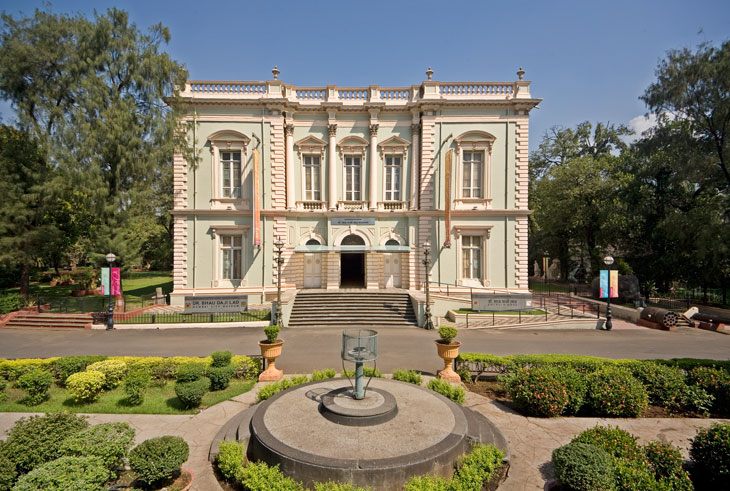
Dr. Bhau Daji Lad Mumbai City Museum
The BDLM, formerly the Victoria and Albert Museum, is Mumbai’s oldest museum. First established on another site in 1855, it moved in 1872 to a specially-designed building that by the end of the 20th century had fallen into disrepair. In 2003, the non-profit Indian National Trust for Art and Cultural Heritage (INTACH) joined forces with the Jamnalal Bajaj Foundation and the Municipal Corporation of Greater Mumbai to undertake a painstaking refurbishment of the building, aided by historian and donor Tasneem Zakaria Mehta. The results were spectacular. In 2008, the building reopened with its High Victorian architecture fully restored, and the collection (which pays special attention to the history of the city of Mumbai), back on display amid high vaulted mosaic ceilings, intricate Minton tiled floors, etched glass and gold details, and freshly painted Corinthian columns.
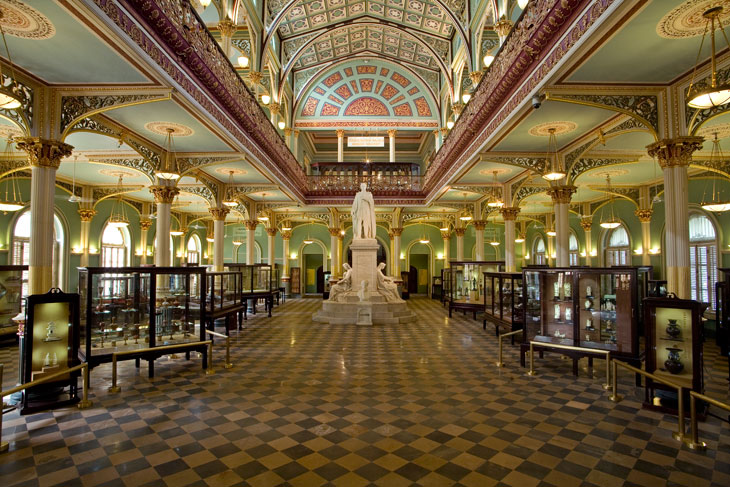
The Industrial Arts Gallery at the Dr. Bhau Daji Lad Mumbai City Museum
With the renovation complete – and an expansion project underway – Zakaria Mehta, who is now honorary director of the museum, is focusing on recontextualising the space; safeguarding its history while encouraging contemporary discourse and creating a platform for public outreach. One curatorial initiative invites contemporary artists to engage with the building and its collections – a collaborative effort between institution and artist, which results in a special exhibition. Leading artists such as Dayanita Singh, Nalini Malani, Atul Dodiya, and the collective CAMP, have all participated, raising the museum’s contemporary profile. A second temporary exhibition space hosts shows of a more varied nature, not limited to the fine arts: a recent display highlighted the work of a group of local activists and urban planners – urbz – who are inspired by the hybrid character of the city’s architecture and its residents. Additionally, local community events, including music and Marathi theatre performances, have successfully engaged a regional audience.
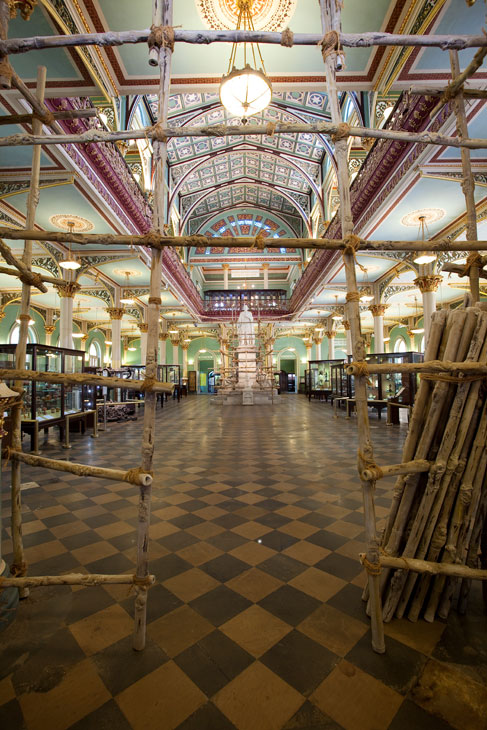
Installation view of ‘Field Notes: Tomorrow was here yesterday’ by Jitish Kallat (23 April–9 October, 2011)
Such initiatives may seem customary to European or North American audiences, but in the subcontinent they are rare. This ambitious, public-facing programming is particularly apt at the BDLM, given the museum’s minimal entrance fee and its proximity to a popular local zoo, which ensures that it sees unusually high footfall and broad public participation. Most arts institutions in the country fail to attract such diversity, primarily serving privileged audiences. Clearly the relationship between cultural legacy, contemporary practice, and audience outreach in India’s institutions needs to evolve. Too often, as Zakaria Mehta puts it, ‘the contemporary is not taking root.’
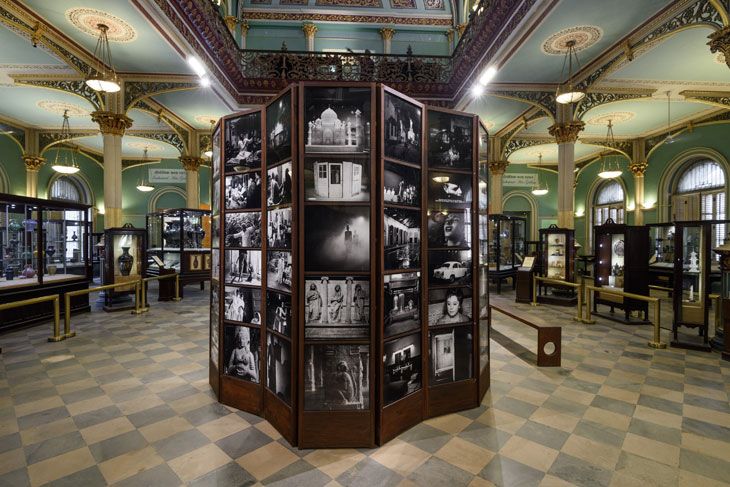
Installation view of ‘The Suitcase Museum’ by Dayanita Singh, curated by Tasneem Zakaria Mehta (11 December 2016–21 February 2017.)
BDLM stimulates critical public discourse about India’s past and present – something that remains unusual, even within the region’s educational institutions. Among the historic displays, for example, is a set of 19th-century dioramas portraying different sections of the country’s population – small, pseudo-anthropological figurines intended to classify regional ‘Indianness’. The inclusion of the figurines begs the question of which audience is being catered to: such a display is surely not for the benefit of the local population. When I asked Zakaria Mehta why she didn’t remove this controversial part of the collection from the public eye, her reply was simple: In order for the country to engage with its multiple imperial histories, such histories must first be made legible, and accessible.
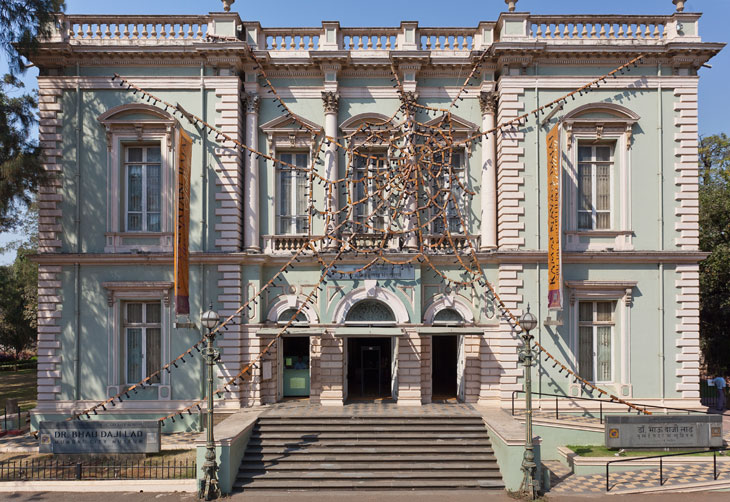
Untitled (2013), Reena Kallat. Part of ‘Zegnart Public / India’ (2 March–28 May 2013)

Mumbai’s oldest museum looks to the future
Installation view of 'This too shall pass' by Sudarshan Shetty, curated by Tasneem Zakaria Mehta (26 Septemberl–30 October, 2010). © Dr. Bhau Daji Lad Mumbai City Museum
Share
Lack of involvement or funding from the state has taken its toll on many of India’s museums and cultural sites. However, there have also been instances of private organisations and individuals getting involved with local heritage – often by taking over partial, or even total, management of a public institution. The successful bid to classify the neo-gothic and art deco neighbourhoods of South Mumbai as UNESCO World Heritage sites in 2012, for instance, was funded and handled by private stakeholders. The transformation of the Dr. Bhau Daji Lad Mumbai City Museum (BDLM) is another success story – one that could provide a model for other institutions.
Dr. Bhau Daji Lad Mumbai City Museum
The BDLM, formerly the Victoria and Albert Museum, is Mumbai’s oldest museum. First established on another site in 1855, it moved in 1872 to a specially-designed building that by the end of the 20th century had fallen into disrepair. In 2003, the non-profit Indian National Trust for Art and Cultural Heritage (INTACH) joined forces with the Jamnalal Bajaj Foundation and the Municipal Corporation of Greater Mumbai to undertake a painstaking refurbishment of the building, aided by historian and donor Tasneem Zakaria Mehta. The results were spectacular. In 2008, the building reopened with its High Victorian architecture fully restored, and the collection (which pays special attention to the history of the city of Mumbai), back on display amid high vaulted mosaic ceilings, intricate Minton tiled floors, etched glass and gold details, and freshly painted Corinthian columns.
The Industrial Arts Gallery at the Dr. Bhau Daji Lad Mumbai City Museum
With the renovation complete – and an expansion project underway – Zakaria Mehta, who is now honorary director of the museum, is focusing on recontextualising the space; safeguarding its history while encouraging contemporary discourse and creating a platform for public outreach. One curatorial initiative invites contemporary artists to engage with the building and its collections – a collaborative effort between institution and artist, which results in a special exhibition. Leading artists such as Dayanita Singh, Nalini Malani, Atul Dodiya, and the collective CAMP, have all participated, raising the museum’s contemporary profile. A second temporary exhibition space hosts shows of a more varied nature, not limited to the fine arts: a recent display highlighted the work of a group of local activists and urban planners – urbz – who are inspired by the hybrid character of the city’s architecture and its residents. Additionally, local community events, including music and Marathi theatre performances, have successfully engaged a regional audience.
Installation view of ‘Field Notes: Tomorrow was here yesterday’ by Jitish Kallat (23 April–9 October, 2011)
Such initiatives may seem customary to European or North American audiences, but in the subcontinent they are rare. This ambitious, public-facing programming is particularly apt at the BDLM, given the museum’s minimal entrance fee and its proximity to a popular local zoo, which ensures that it sees unusually high footfall and broad public participation. Most arts institutions in the country fail to attract such diversity, primarily serving privileged audiences. Clearly the relationship between cultural legacy, contemporary practice, and audience outreach in India’s institutions needs to evolve. Too often, as Zakaria Mehta puts it, ‘the contemporary is not taking root.’
Installation view of ‘The Suitcase Museum’ by Dayanita Singh, curated by Tasneem Zakaria Mehta (11 December 2016–21 February 2017.)
BDLM stimulates critical public discourse about India’s past and present – something that remains unusual, even within the region’s educational institutions. Among the historic displays, for example, is a set of 19th-century dioramas portraying different sections of the country’s population – small, pseudo-anthropological figurines intended to classify regional ‘Indianness’. The inclusion of the figurines begs the question of which audience is being catered to: such a display is surely not for the benefit of the local population. When I asked Zakaria Mehta why she didn’t remove this controversial part of the collection from the public eye, her reply was simple: In order for the country to engage with its multiple imperial histories, such histories must first be made legible, and accessible.
Untitled (2013), Reena Kallat. Part of ‘Zegnart Public / India’ (2 March–28 May 2013)
Share
Recommended for you
A potted history of studio ceramics
Studio potters continue to push the boundaries of their medium in Britain
Boris, you owe us £37 million
The Garden Bridge Trust should be pursued for the public money it has wasted
Julian Assange, master of the (dark) arts
What we learnt about Julian Assange and art from his profile in the New Yorker